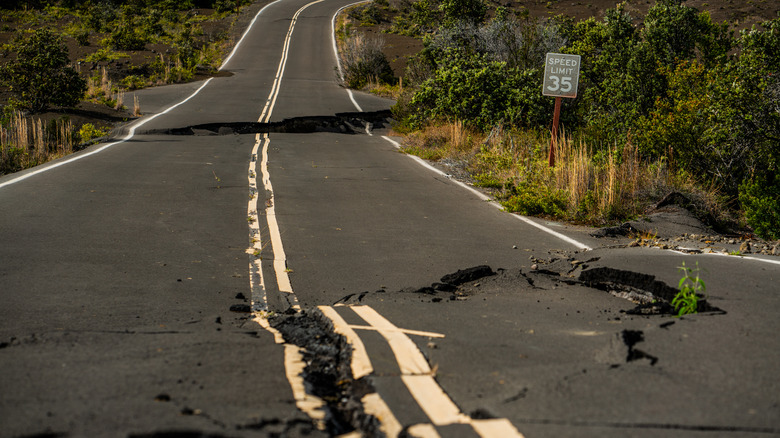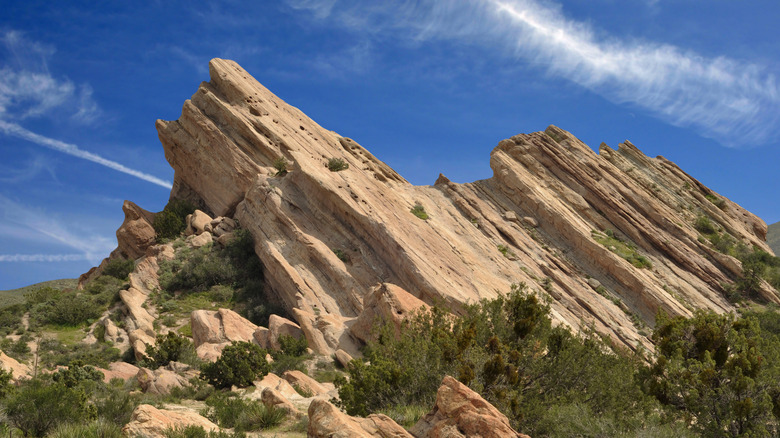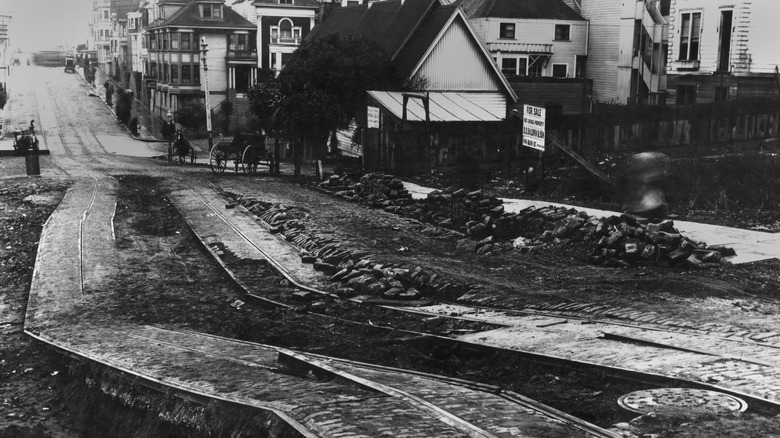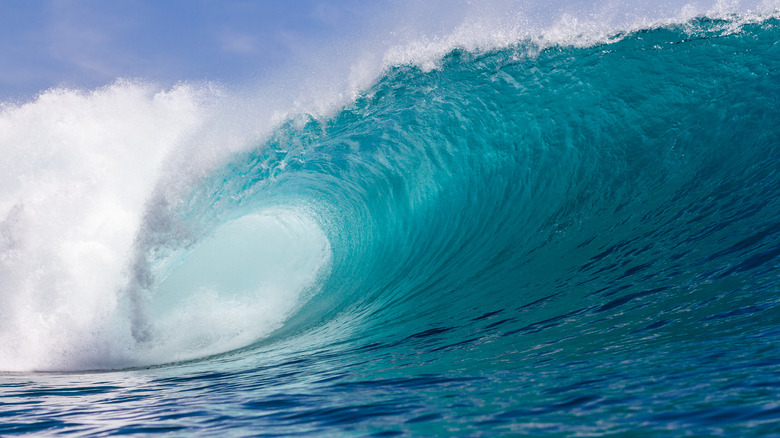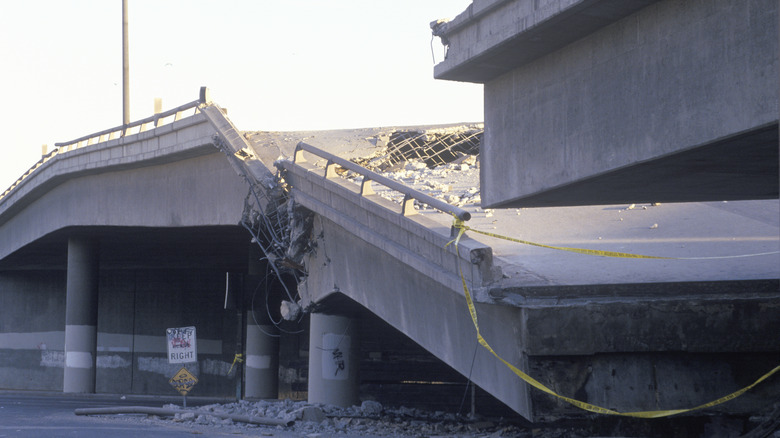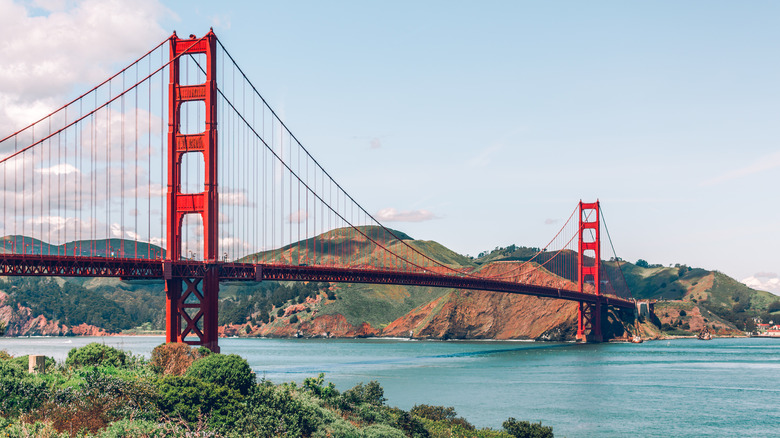What Would Happen If The San Andreas Fault Unleashes The Fabled 'Big One'
Catastrophic earthquakes tend to happen about every 200 years, according to the U.S. Geological Survey. But we still can't actually predict when or where earthquakes will happen with much certainty, per Scientific American. Sometimes scientists spot stress cracks in the soil near the faultlines or detect tiny warning quakes before the ground begins to shift miles underground, but sometimes there are no signs at all. One major earthquake zone is the San Andreas fault line, leaving residents wondering: When will it produce the next really massive earthquake, and what will California look like in the aftermath of the "Big One"?
According to the Michigan Technical Institute, the earthquake magnitude scale starts at around 2.5. These baby quakes happen millions of times each year, but we can't feel them. Humans start to feel earthquakes between 3 to 5 magnitude, which cause shaking and some damage. When you get to 6 and 7, you're experiencing a major, strong earthquake that can leave behind serious damage. And when quakes about a magnitude of 8 hits ... that's what they call a "Big One." The largest ever recorded was a 9.5 magnitude that rumbled through Italy in the 1980s (via Scientific American).
A strong quake is pretty likely
The U.S. Geological Survey tells us that within the next three decades, there is a 99% chance of a 6.7 magnitude earthquake or stronger hitting California. There is about a 46% chance that a 7.5 magnitude or greater earthquake will hit, which are significantly lower odds.
Some spots are more vulnerable to the effects of an earthquake than other cities, according to Geology. The San Andreas fault line runs from the top of the state, near Point Delgada, then runs along the coast and ends near Brawley. People who live along the ridge of the fault line — in cities like San Francisco, San Jose, Palm Springs, or Hollister — will be most vulnerable to the quake when it happens.
The San Andreas "transform fault" has large tectonic plates that move super slowly most of the time, hidden deep below ground. Each year, these plates push up against each other, and the harder they push, the more pressure builds up. After years, decades, or even centuries, the pressure becomes too much, and the plates slip or break, smashing into each other and causing an earthquake.
The San Andreas fault line is where two huge tectonic plates meet, which is why the damage there will be so devastating. In fact, it's one of the only places in the whole world where you can see tectonic plates pushed up against each other since they jut up onto the surface.
Quake myths versus reality
As Geology reports, the good news is when the Big One hits, California won't break off the U.S., nor will it slide into the sea. To figure out what would happen during a big quake, a group of researchers created The ShakeOut Scenario, a report by the U.S. Geological Survey released in 2008. They predicted what will happen when The Big One arrives, using the area around the Salton Sea and Lake Hughes as the starting point of the theoretical 7.8-magnitude quake.
According to their findings, nearly 1,000 California roads cross the fault line at some point, some of which will sustain heavy damage. As the fault cracks, it will wreak havoc on train tracks, natural gas pipelines, and power lines. These scientists believe that some of the hardest-hit areas in this hypothetical study would be Coachella Valley, Cajon Pass, and Big Pines Highway. The study also presents the scary possibility that the shaking plates could lurch sideways and shove objects up to 30 feet from where they're rooted.
Unexpected hazards
According to Insider, to keep safe during the earthquake, stay still and get low to the ground by crawling under a table or other furniture if possible. If you move around during a quake, you could get cut on shards of glass or hit by moving objects, so it's best to stay covered and wait until the motion stops. Plus, for a very dangerous earthquake like the theoretical 7.8-magnitude Big One, older buildings that aren't up to current earthquake codes are at risk of collapse.
Falling electrical wires and debris can harm people, but a lesser-known threat of earthquakes is causing fatal fires. Since the quake is largely underground, water, gas, and oil pipelines can twist, bend, and puncture through to the surface or even explode. As gas or oil spews out, fires can expand rapidly. And since the underground water lines may have been severed, roughly 60% of the water reserve could be impacted, making it harder to extinguish fires and leaving residents without access to water (experts recommend keeping a 14-day water supply on hand for this reason).
According to the Pacific Northwest Seismic Network (PNSN), earthquakes can cause aftershocks that lead to tsunamis, which send huge waves of water crashing into land. That then leads to flooding, PNSN reports. Even small bodies of water, like swimming pools, can launch overpowering waves of water in a phenomenon called seiche.
Nightmare scenario for first responders
Infrastructure is going to be impacted, too — not just buildings, but bridges could warp, train tracks could twist to delay all kinds of imports, and highways could become unsound or broken (via Insider). Public transportation? Forget about it. There might be limited or zero transportation for weeks until the major damage has been fixed.
Fire trucks and ambulances will be impacted by the roadways too, and they might not be able to access people in need of help (per Smithsonian Magazine). Some seismologists think fires could be the most dangerous hazard after the quake because with high heat, low humidity, and strong winds, fires could zip through California with great speed. Keeping a fire extinguisher on hand could be life-saving in the event of an earthquake.
The damage could cost the state of California upward of $200 billion and take a year or more to repair, which could put a dent in both the local and tourist economies (via Insider).
The reality of the 'Big One'
According to Insider, this quake could potentially be very deadly; some estimates say that it could kill around 1,800 people and injure 50,000. The biggest the predicted earthquake would be is around an 8.3 magnitude, which would be colossally destructive, ripping a path from the tip of California right down to Mexico, according to Smithsonian Magazine. In this worst-case scenario, the entire San Andreas faultline would be impacted. The actual earthquake will probably be much smaller.
Now that you've heard about the worst-case scenario and know how to prepare for it, you can take a deep breath and relax, because there is only about a 7% chance that a magnitude 8 Big One will happen in the next three decades, according to the U.S. Geological Survey's most recent study. According to Smithsonian Magazine, California officials are currently working to prepare old buildings, implement backup communications systems, and educate people with ShakeOut drills, teaching them what to do when the next big earthquake strikes.
